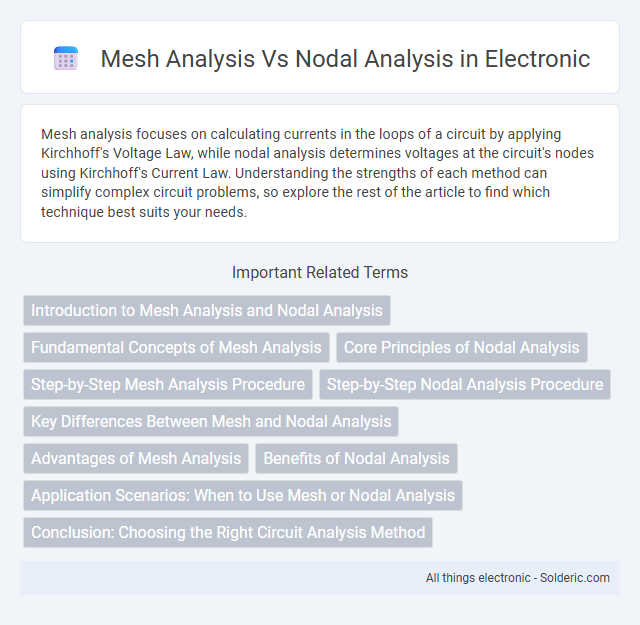Mesh analysis focuses on calculating currents in the loops of a circuit by applying Kirchhoff's Voltage Law, while nodal analysis determines voltages at the circuit's nodes using Kirchhoff's Current Law. Understanding the strengths of each method can simplify complex circuit problems, so explore the rest of the article to find which technique best suits your needs.
Comparison Table
| Aspect | Mesh Analysis | Nodal Analysis |
|---|---|---|
| Definition | Analyzes circuit by writing KVL equations around meshes (loops). | Analyzes circuit by writing KCL equations at nodes (junctions). |
| Applicable To | Planar circuits with well-defined meshes. | Any circuit, especially useful for circuits with many nodes. |
| Main Variables | Mesh currents. | Node voltages. |
| Equations Count | Number of independent meshes. | Number of nodes minus one (reference node). |
| Method | Apply Kirchhoff's Voltage Law (KVL). | Apply Kirchhoff's Current Law (KCL). |
| Complexity | Simpler for circuits with fewer meshes. | Simpler for circuits with fewer nodes or many current sources. |
| Use Case | Preferable for voltage source dominated circuits. | Better for current source dominated circuits and circuits with non-planar topology. |
Introduction to Mesh Analysis and Nodal Analysis
Mesh analysis simplifies circuit solving by focusing on loop currents in planar circuits, applying Kirchhoff's Voltage Law (KVL) to generate simultaneous equations. Nodal analysis concentrates on node voltages relative to a reference node, utilizing Kirchhoff's Current Law (KCL) to establish the necessary equations for circuit behavior. These methods are fundamental in electrical engineering for analyzing complex circuits systematically and efficiently.
Fundamental Concepts of Mesh Analysis
Mesh analysis is a systematic method used in electrical circuit theory to determine the currents flowing in planar circuits by applying Kirchhoff's Voltage Law (KVL) around each mesh or loop. It relies on assigning mesh currents to independent loops and solving simultaneous linear equations derived from the sum of voltage drops equaling zero in each mesh. This technique simplifies complex circuit problems by reducing the number of equations needed compared to analyzing individual components, especially in circuits with multiple loops.
Core Principles of Nodal Analysis
Nodal analysis is based on Kirchhoff's Current Law (KCL), which states that the sum of currents entering a node equals the sum of currents leaving the node, allowing for the systematic calculation of node voltages in an electrical circuit. It simplifies circuit analysis by focusing on potential differences at circuit nodes relative to a reference node, typically ground. This method efficiently handles networks with multiple branches and voltage sources, making it ideal for circuits where current paths are complex.
Step-by-Step Mesh Analysis Procedure
Identify mesh currents in each independent loop of the circuit and assign a direction, typically clockwise. Apply Kirchhoff's Voltage Law (KVL) around each mesh to establish equations based on voltage drops and rises caused by resistors, voltage sources, and other elements. Solve the resulting simultaneous equations for mesh currents to determine circuit behavior, ensuring thorough verification of each step to maintain accuracy.
Step-by-Step Nodal Analysis Procedure
Nodal analysis involves identifying all nodes in the circuit and selecting a reference node (ground) to assign zero voltage. Next, apply Kirchhoff's Current Law (KCL) at each non-reference node, writing equations that sum currents leaving or entering the node, expressed in terms of node voltages. Finally, solve the resulting system of linear equations to determine the unknown node voltages, which can be used to find branch currents and other circuit parameters.
Key Differences Between Mesh and Nodal Analysis
Mesh analysis uses loop currents to solve planar circuits, while nodal analysis relies on node voltages to determine circuit parameters. Mesh analysis is most effective for circuits with fewer loops, whereas nodal analysis excels in circuits with fewer nodes. The choice between these methods depends on circuit complexity and the number of components connected at nodes or loops.
Advantages of Mesh Analysis
Mesh analysis offers efficient solutions for planar electrical circuits by simplifying complex networks into loop currents, reducing the number of equations compared to node voltage methods. It is particularly advantageous in circuits dominated by voltage sources and fewer meshes than nodes, improving calculation speed and clarity. Your circuit analysis becomes more straightforward when using mesh analysis for such configurations, leading to accurate and organized results.
Benefits of Nodal Analysis
Nodal analysis simplifies circuit equations by focusing on node voltages, reducing the number of variables compared to mesh analysis, especially in circuits with many loops. It is highly efficient for circuits with multiple parallel branches, making it easier to handle complex networks. Using nodal analysis, you can quickly determine the voltage at any node, providing a direct insight into your circuit's behavior.
Application Scenarios: When to Use Mesh or Nodal Analysis
Mesh analysis is ideal for planar circuits with fewer loops, simplifying calculations by focusing on loop currents, making it highly effective in circuits dominated by series elements. Nodal analysis excels in circuits with multiple nodes and complex connections, especially when voltage sources and parallel components are prevalent, allowing straightforward determination of node voltages. Your choice between mesh and nodal analysis depends on the circuit's topology: use mesh analysis for simpler loop-centric designs and nodal analysis for node-intensive circuits with numerous branches.
Conclusion: Choosing the Right Circuit Analysis Method
Mesh analysis is preferred for planar circuits with fewer loops, offering straightforward application of Kirchhoff's Voltage Law. Nodal analysis excels in circuits with many nodes or non-planar layouts, leveraging Kirchhoff's Current Law for efficient voltage determination. Optimal circuit analysis depends on the specific topology and complexity, with mesh analysis suitable for loop-focused problems and nodal analysis ideal for node voltage solutions.
mesh analysis vs nodal analysis Infographic

 solderic.com
solderic.com